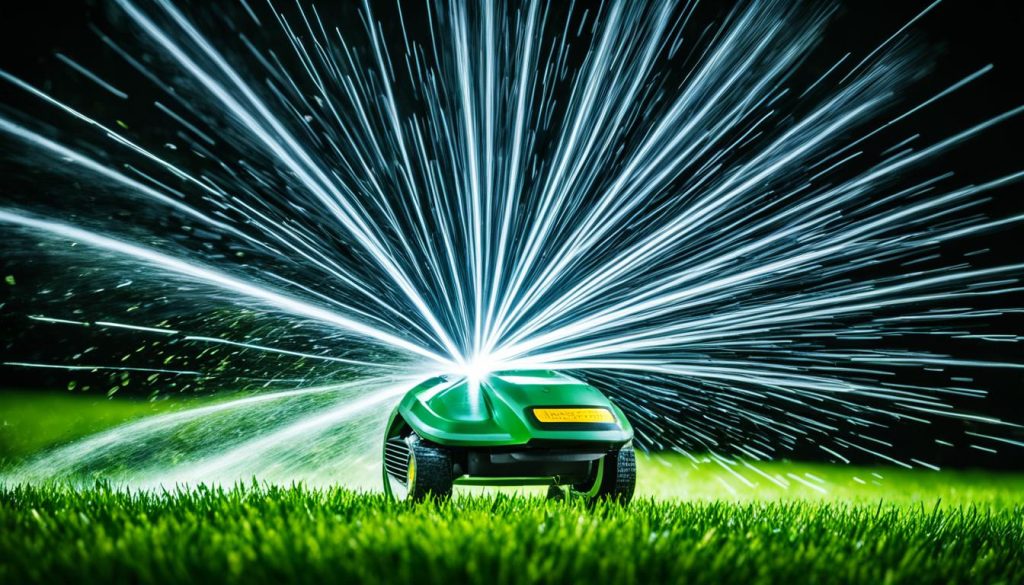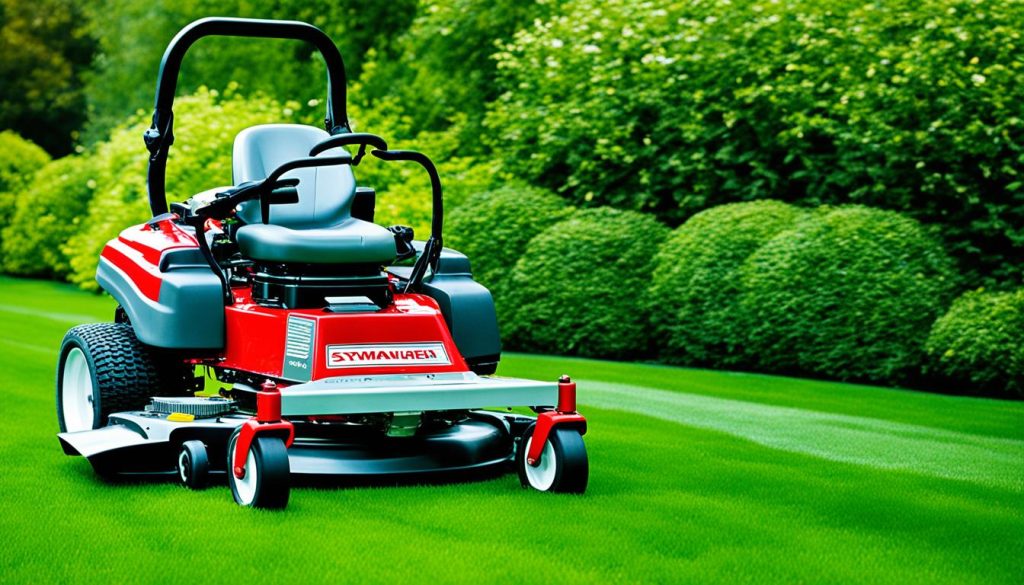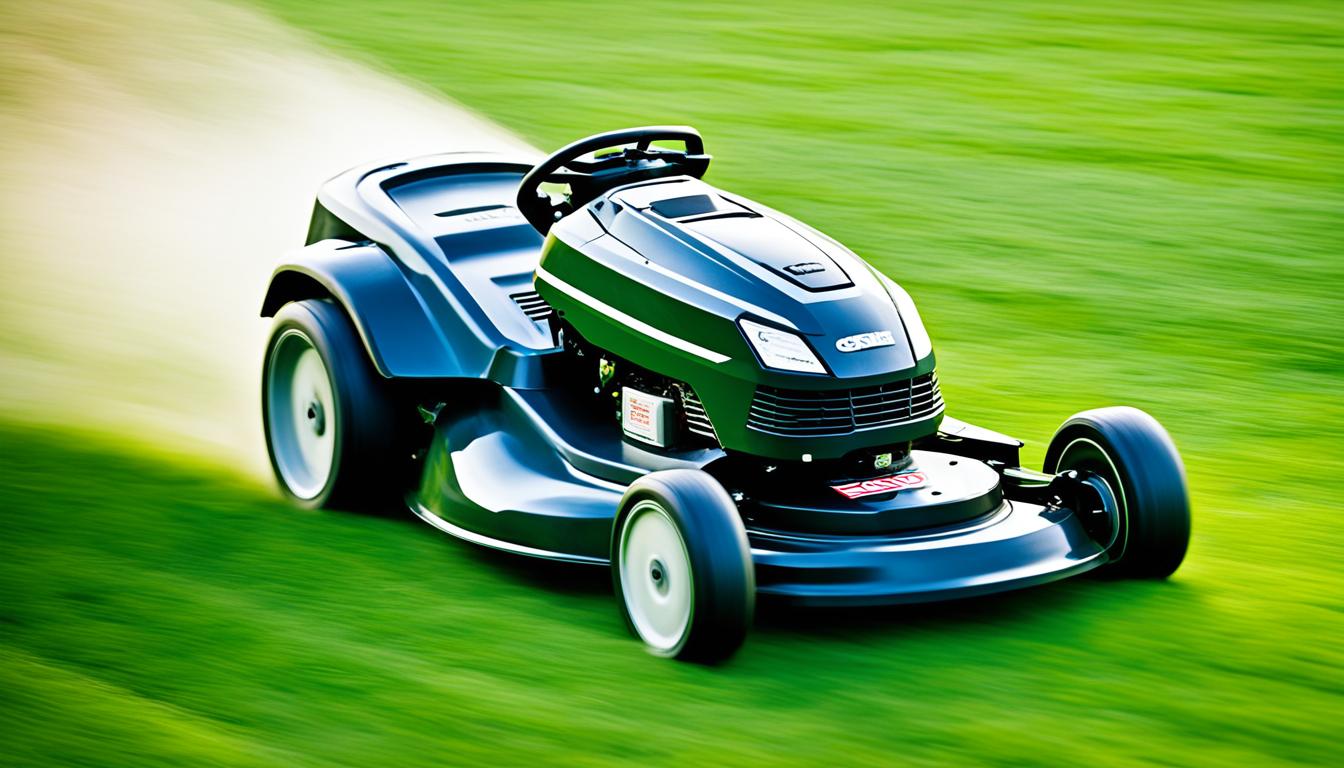Are you tired of your lawn mower taking forever to get the job done? Have you ever wondered if there’s a way to make it go faster? Well, you’re not alone. Many homeowners have questioned whether it’s possible to increase the speed and performance of their lawn mowers. And the answer is: yes, it is!
In this article, we will explore various methods and modifications that can help you make your lawn mower faster and more efficient. From adjusting the engine pulley and modifying the governor to cleaning or replacing the air filter and using the right engine oil, we will cover everything you need to know to unleash the full potential of your mower. So, get ready to rev up your mowing game!
- Adjusting the engine pulley can increase the speed of belt-driven mowers with two engine pulleys.
- Modifying the governor can bypass the speed limitations set by the manufacturer.
- Cleaning or replacing the air filter can improve the performance of your lawn mower.
- Using the right engine oil optimized for small engines can enhance speed and efficiency.
- Upgrading tires and wheels can contribute to increased speed and overall mower performance.
Adjusting the Engine Pulley
One way to make your lawn mower faster is to adjust the engine pulley. This modification is applicable to belt-driven mowers with two engine pulleys. By increasing the size of both pulleys, you can effectively increase the speed of your lawn mower.
The engine pulley, located on the engine’s crankshaft, plays a vital role in determining the mower’s speed. The other pulley is situated behind the lawn mower. By adjusting both pulleys to larger sizes, you can optimize the power transfer and increase the rotational speed of the blades.
However, it’s important to note that this method is only applicable to belt-driven mowers with two engine pulleys. Other types of mowers may have different mechanisms and require alternative modifications.
Modifying the Governor
The governor of a lawn mower plays a crucial role in controlling fuel flow and setting an upper speed limit to prevent over-speeding. While its primary function is fuel regulation, you can make certain modifications to increase the speed of your lawn mower. T-Quip, an Australian equipment rental company, suggests a couple of approaches to achieve this.
Reducing the Spring Length
One method to modify the governor involves reducing the length of the spring attached to it. By shortening the spring, you can potentially increase the speed of the lawn mower. This adjustment allows for a higher fuel flow and enables the engine to reach higher revolutions per minute (RPM), resulting in a faster mower.
Removing the Spring
If reducing the spring length does not yield the desired speed increase, you may consider removing the spring completely. This modification allows the governor to have minimal influence over the engine’s RPM, thus allowing for higher speeds. However, it’s important to note that removing the spring entirely may result in less precise fuel regulation and could potentially strain the engine if operating at extremely high RPMs.
It’s essential to understand that modifying the governor goes beyond its intended design and may impact the overall performance and safety of your lawn mower. Proceeding with caution and ensuring you observe any relevant local laws or regulations is highly recommended.
Next, we’ll explore the importance of cleaning or replacing the air filter in Section 4.
Cleaning or Replacing the Air Filter
A dirty or clogged air filter can significantly impact the performance of your lawn mower, causing a decrease in speed and efficiency. To ensure optimal air intake and improve the overall engine performance, it is essential to regularly clean or replace the air filter.
The air filter is typically located on the left side of the mower’s engine. Debris such as grass clippings, dirt, and dust can accumulate over time, obstructing the airflow. This restriction can reduce the engine’s ability to generate power, resulting in a slower and less effective mowing experience.
Regular cleaning of the air filter involves gently removing it from its housing and using compressed air or a soft brush to remove any accumulated debris. Ensure that all foreign particles are thoroughly removed before reinserting the filter.
If the air filter is severely clogged or damaged, a replacement filter may be necessary. It is recommended to consult your lawn mower’s manual or contact the manufacturer to determine the appropriate replacement filter for your specific model.
By maintaining a clean air filter, you can enhance the speed and performance of your lawn mower, allowing for efficient cutting and a smoother mowing experience. Regular inspection and maintenance of the air filter are crucial to ensure optimal engine performance.
Using the Right Engine Oil
Just like a car, the engine of your lawn mower requires regular oil changes to ensure smooth operation. Changing the engine oil regularly can optimize blade rotation and overall performance. It’s important to choose the right type of oil for your lawn mower’s engine. Using a high-quality engine oil suitable for small engines can help improve speed and efficiency. Avoid using substandard oils that may damage the mower’s engine.

To maximize the performance of your lawn mower, consider the following tips when selecting the appropriate engine oil:
- Check the manufacturer’s recommendations: Consult the owner’s manual or the manufacturer’s website for specific recommendations on the type and viscosity of oil to use.
- Choose oil specifically designed for small engines: Lawn mowers have unique requirements, and using oil formulated for small engines ensures optimal performance and protection.
- Consider the viscosity: Different climates and operating conditions require different oil viscosities. Ensure that the oil you choose is suitable for the temperature range in which you’ll be using your lawn mower.
- Opt for synthetic oil: Synthetic oils offer enhanced performance and protection compared to conventional oils. They can handle higher temperatures, reduce engine wear, and provide better fuel efficiency.
- Follow the recommended oil change intervals: Regularly changing the engine oil according to the manufacturer’s guidelines is crucial for maintaining performance, preventing premature wear, and extending the life of your lawn mower.
Engine Oil Recommendations
| Engine Oil Type | Suitable Applications |
|---|---|
| SAE 30 | Standard viscosity for most small engines |
| 10W-30 | Versatile oil suitable for a wide range of temperatures |
| 5W-30 | Recommended for colder climates |
| 10W-40 | For hotter climates and heavy-duty applications |
By choosing the right engine oil and adhering to a regular maintenance schedule, you can optimize blade rotation, protect the engine from premature wear, and ensure the longevity of your lawn mower.
Choosing the Right Lawn Mower for Speed
If you’re looking to increase the speed of your lawn mower, it’s important to start with a model that is capable of handling higher speeds. Look for mowers with a powerful engine, preferably those designed for commercial use. A larger engine size, such as a 600cc or 700cc, can provide more horsepower and torque for better performance. Additionally, consider the overall construction and durability of the mower, especially in the frame and suspension, to ensure it can handle the stress of higher speeds.
Key Features to Consider:
- Powerful engine designed for commercial-grade performance.
- Larger engine size for increased horsepower and torque.
- Durable construction and robust frame to handle higher speeds.
- Sturdy suspension system for added stability and control.
- Advanced cutting technology for efficient and precise mowing.
By selecting a lawn mower with these features, you’ll have a solid foundation for enhancing its speed and performance. A powerful engine provides the necessary power to handle higher speeds, and a well-built mower can withstand the demands of increased performance modifications.
| Key Factors | Benefits |
|---|---|
| Powerful Engine | Enhanced speed and performance capabilities |
| Durable Construction | Long-lasting and reliable performance |
| Commercial-Grade Design | Suitable for modification and customization |
Remember, it’s essential to choose a lawn mower that is not only powerful but also suitable for modification. A commercial-grade mower often provides more options for customization and performance upgrades, allowing you to fine-tune its speed and capabilities to meet your specific needs.
Modifying the Engine and Transmission
To further improve the speed and performance of your lawn mower, you can explore modifications to both the engine and transmission components. Making adjustments and upgrades in these areas can significantly enhance the overall speed and efficiency of your mower.
Modifying the Engine
In order to optimize the performance of your lawn mower, consider the following modifications to the engine:
- Install a high-performance air filter and exhaust system: Upgrading the air filter and exhaust system can improve the engine’s airflow and increase horsepower.
- Upgrade the carburetor and fuel system: A more efficient carburetor and fuel system can enhance fuel delivery and combustion, resulting in improved engine performance.
- Replace the spark plug and ignition system: Upgrading the spark plug and ignition system can promote better engine ignition, leading to smoother operation and increased power.
- Install a performance camshaft and valve train: Upgrading the camshaft and valve train can optimize valve timing and lift, maximizing the engine’s power output.
Implementing these engine modifications can result in a more powerful and responsive lawn mower, enhancing its speed and overall performance.
Modifying the Transmission
The transmission of your lawn mower plays a crucial role in transmitting power from the engine to the wheels. By making the following modifications to the transmission, you can further improve your mower’s speed and performance:
- Change the gear ratio: Adjusting the gear ratio can optimize the balance between speed and torque, allowing the mower to achieve higher speeds.
- Upgrade the clutch and drive belt: Replacing the clutch and drive belt with high-performance alternatives can improve power transfer and eliminate slippage, resulting in better acceleration and speed.
By modifying the engine and transmission components of your lawn mower, you can unlock its full potential, significantly improving its speed, power, and overall performance.
Upgrading Tires and Wheels
Upgrading the tires and wheels on your lawn mower can greatly enhance its speed and performance. By investing in high-quality tires specifically designed for high-speed use, you can optimize the mower’s traction and overall handling. Look for tires with a low profile and superior grip to ensure optimal performance on various terrains. Additionally, consider the circumference of the tires, as larger tires can provide higher top speeds.
When upgrading your lawn mower’s wheels, opt for racing-grade options that are both sturdy and lightweight. These wheels are designed to withstand the demands of high-speed operation while contributing to improved handling. Lightweight wheels help reduce the overall weight of the mower, enhancing its acceleration and maneuverability.
Here is a comparison of different tire and wheel upgrades for your lawn mower:
| Tire/Wheel Upgrade | Key Features |
|---|---|
| High-Speed Tires | Designed for maximum speed and performance |
| Low-Profile Tires | Improved traction and stability |
| Larger Circumference Tires | Higher top speeds, but consider engine capacity |
| Racing-Grade Wheels | Sturdy and lightweight for enhanced handling |
Remember to consider the compatibility of these upgrades with your specific lawn mower model and its engine capacity. Upgrading tires and wheels can significantly improve your lawn mower’s speed, making your mowing tasks more efficient and enjoyable.
Installing a Speed Limiter
While it may be tempting to remove the speed limiter on your lawn mower, it is extremely dangerous and not recommended. Lawn mowers are not designed for high-speed operation, and removing the speed limiter can lead to instability and potential accidents. Instead, consider installing a device that allows you to set the maximum speed of your mower. This will ensure your safety while still enjoying a faster mowing experience.

Safety Considerations
- Protective Gear: Always wear appropriate safety gear, including a helmet, gloves, and boots, to safeguard yourself while operating the lawn mower.
- Stability: Removing the speed limiter can compromise the stability of the mower, leading to potential accidents. With a speed limiter in place, you can maintain control and reduce the risk of mishaps.
- Operational Design: Lawn mowers are engineered for optimal performance and safety at their designated speeds. Modifying them for excessive speeds can result in structural damage, reduced maneuverability, and compromised safety features.
By installing a speed limiter, you can adhere to safe speed limits while still attaining improved efficiency and performance from your lawn mower. It’s essential to prioritize your safety and the safety of those around you, ensuring an enjoyable and incident-free mowing experience.
Taking Safety Precautions
When making modifications to your lawn mower for increased speed, it’s crucial to prioritize safety. Always wear appropriate safety gear, such as a helmet, gloves, and boots, to protect yourself while operating the mower. Regularly maintain your mower by checking the brakes, steering, suspension, and other components for wear or damage. Avoid using the mower in areas with steep inclines or obstacles that can pose a safety risk. Follow all safety guidelines and precautions to ensure a safe and enjoyable mowing experience.
- Wear a helmet to protect your head from potential impacts and falling debris.
- Put on gloves to provide grip and protect your hands from sharp edges or hot surfaces.
- Wear sturdy boots to protect your feet from potential injuries.
- Regularly inspect and maintain the brakes to ensure they are in proper working condition and can effectively stop the mower when needed.
- Check the steering system to ensure it is responsive and allows you to safely navigate your lawn.
- Inspect the suspension system to ensure it provides adequate support and stability, especially when maneuvering over uneven terrain.
- Avoid mowing on steep inclines or slopes where the mower’s stability can be compromised.
- Remove any obstacles, such as rocks, branches, or toys, from the mowing area to prevent damage to the mower and potential hazards.
- Read and follow the safety guidelines provided in the lawn mower’s user manual to ensure safe operation.
Conclusion
Making your lawn mower faster requires careful consideration of various components and modifications. By adjusting the engine pulley, modifying the governor, cleaning or replacing the air filter, using the right engine oil, and upgrading tires and wheels, you can effectively boost the speed and performance of your lawn mower. These simple adjustments can make a significant difference in the overall efficiency and effectiveness of your mowing experience.
However, it’s important to keep in mind that modifying your lawn mower may void the manufacturer’s warranty and can have safety implications. Always prioritize safety by wearing proper protective gear and following the recommended guidelines for operation. Regular maintenance is also crucial to ensure optimal performance and longevity of your lawn mower.
In conclusion, by implementing the suggested modifications and practicing responsible maintenance, you can enjoy a faster and more efficient lawn mowing experience. Remember to weigh the potential risks and benefits of modifying your mower, and make informed decisions based on your specific needs and circumstances. With the right approach, you can achieve improved speed and performance without compromising safety or voiding your warranty.





